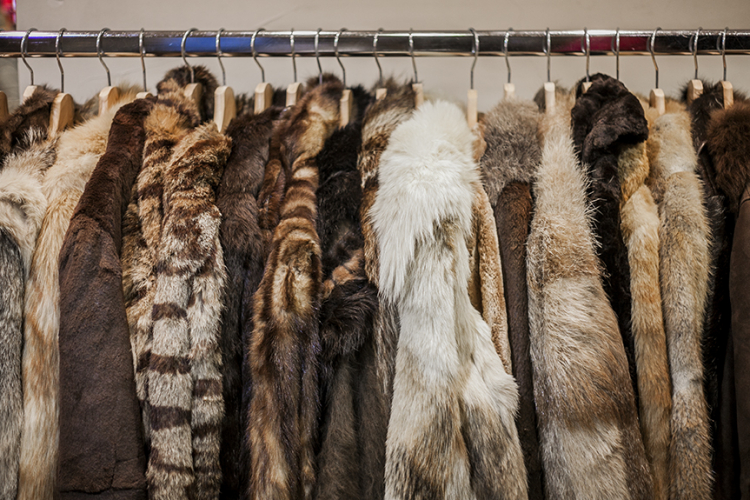Think Twice Before Buying a New Fur Coat

Living in cold climates, one may face themselves brooding the reality of the fur industry while eyeing a fur coat and dreaming of how cozy they would be walking the streets. However, the controversy over fur means that walking away may seem like the easier option.
While some may not support the fur industry and wouldn’t buy a real fur coat, one could possibly be confronted with the concept of buying secondhand fur. This alternative poses the question of guilt, ethics and consumerism.
Many animals such as rabbits, minks and foxes are killed for their fur in what are called fur farms. They endure stress encased in small containers as they await their fate of becoming a fur coat. PETA (People for the Ethical Treatment of Animals), who is outwardly against the fur industry, receives hundreds of donations of unwanted fur coats that they provide to people in need – particularly with winter approaching. Because they can’t bring back the rabbits, minks, foxes and other animals, they believe they can still do good by helping those in need.
Concerning the fur industry, AUP student Sofia Sellar says “we have alternatives now. I think you can be warm in other means, and why would you kill an animal to keep you warm when you could just use something else?"
When asked about how she feels about secondhand fur, Sellar says, “the damage is done, but at the same time it still means people are wearing it. It is still in fashion; it is prompting other people to wear fur, even if it is secondhand. However, I feel like the deed is done, it is fine.”
AUP student Oscar Hartzog considers the idea of thrifting furs, in which he says, “whatever happened already happened so it makes sense because it is already made, so people are going to wear it.” However, he has a similar realization as Sellar and after a pause continues to say, “if the ‘cool kids’ start wearing fur, then that starts a trend. That means more fur.”
Lady on the Train in Fur. Image credit: Valeria Sarto
Elle contributor Pamela Erens, in her article “Why Do I Have to Defend My Decision to Wear Fur?” offers a different perspective. Erens asks the reader to consider why they care about her fur coat when it serves a practical purpose of keeping her warm. Hartzog mentioned the issues that arise with fur coats: “Are they waterproof? No, they are not even that practical. They are a style move, a flex.”
Sellar says “I don’t think you need fur to be warm. Fur is a fashion thing and it becomes a money symbol. You have a beautiful fur coat and it’s like, 'look at me, I have an animal on me and it keeps me warm'… which is kind of morbid if you think about it.”
However, Sellar and Hartzog are from rather warm climates: Miami Beach and Los Angeles respectively. On the other hand, Canadian-born & AUP professor Madeleine Czigler mentions that in truly cold climates a fur coat is the only thing that keeps you warm.
Although from the city of never-ending summer, Sellar brings up an interesting perspective regarding consumerism. Her great-great grandfather, from Russia, would make fur coats, however, she says “but he would utilize the whole animal, using the meat for food, hide (skin) for leather and also the fur for clothing.”
It makes sense that from a practical way of use, it would not be frowned upon in places such as Canada or Russia where the weather drops way below freezing. It is a different story in climates that are not at that level of cold weather.
We live in a different era, though, where we have a mix of mass production and mass consumption. We do not consume locally, nor do we utilize an entire animal for all it has to “offer” us. Fur farms are specifically just to utilize the animal for its fur.
Maybe, it becomes more of an issue about the way our society is treating these animals for a product.
Erens, in her article mentioned above, also suggests that the reader think twice before judging her. She asks “why do you care so much about my fur coat, but eat meat and wear leather?” This brings up a fair point in terms of ethical standards.
After making a conscious decision to reduce my consumption of meat, ordering a fresh steak or chicken was out of the question. However, if invited to a dinner party offering already prepared meat on the “menu,” leaving it to get thrown away made me think twice. The animal has already been killed and sold, its death would have been for no reason if it just went into the trash.
This could translate to the idea of getting a secondhand coat, in which it has already been made. However, you have the decision to decide whether or not that hanger has to be refilled by another fur coat.
Nonetheless, even luxury brands are leaning toward a fur-free stance. Gucci and Stella McCartney have gone fur-free and London Fashion Week went fur-free in 2018. Although there may be a stop to fur one day, it is unclear whether the selling of fur will ever be banned. Especially while browsing through secondhand and thrift shops, shoppers are frequently confronted with an array of luscious fur coats.
Faux Fur Coats at Kilo Shop. Image credit: Valeria SartoFaux fur coats are an alternative if you are against the fur industry, but unfortunately faux fur is also not so great for the environment.
If this is driving you in circles, you are not alone. There may be no full answer to whether or not secondhand fur will clear you of guilt, but it is up to you to make your own conscious and educated decision — just like everybody else.









